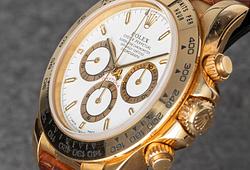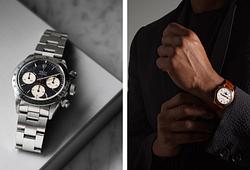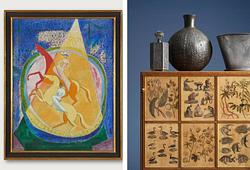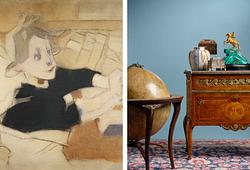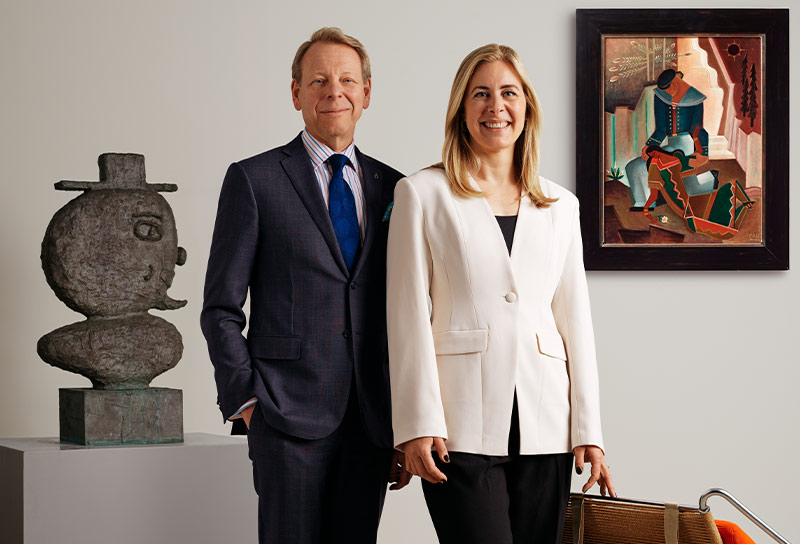Andy Warhol
Scandinavian Beauty
Signed Andy Warhol and dated 1977 on the overlap. Silkscreen ink and synthetic polymer paint on canvas 102 x 102 cm.
Alkuperä - Provenienssi
Acquired from the artist.
Muut tiedot
After creating some of the most famous works of art of the 20th Century, around 1965, Andy Warhol chose to spend the remainder of the 60’s creating art films. This was unfortunately interrupted by the spectacular murder attempt which he survived in 1968 to spend the rest of the 60’s as a convalescent.
In the beginning of the 70’s, Warhol will focus on what became his staple of this era: portraits of the rich, famous and beautiful. In 1969 he made a portrait of his Swiss art dealer Bruno Bischofberger, which initiated a number of orders from some of the world’s most important art gallery owners such as Ileana Sonnabend (1973) and Leo Castelli (1975). Other portraits of importance during the 70’s is the suite of paintings he did of Mao, which kept Warhol busy for the first half of that decade.
The portait painting came to be more than just portraits and was a natural continuation of the earlier focus on the “superstars” such as Liz, Jackie and Elvis. Warhol’s international clientele included, more or less, everyone who was “someone of importance”. Among the immortalized were, to name a few, musical artists (Mick Jagger and Liza Minelli), fashion designers (Yves Saint Laurent, Halston och Diane von Furstenberg), movie stars (Dennis Hopper), and famous artist colleagues (David Hockney and Roy Lichtenstein).
Warhol’s world was by no means limited to the cultural sphere. In 1976, Warhol captured U.S. President Jimmy Carter, and a trip to Tehran the same year resulted in an order of no less than twelve portraits of Farah Diba. By the mid 70’s there were not many doors that weren’t wide open for the premiere pop-artist in the world. No matter how famous, how wealthy or how much power and influence one had, there were always new goals to pursue and achieve, so a portrait by Warhol was one of the ultimate privileges.
Around 1970, Andy Warhol bought his first Polaroid “Big Shot” camera, the camera that became his favourite camera to use for his work. Warhol usually travelled with two identical cameras in case one would break. He even kept a number of Big Shot cameras in his friend and business partner’s home in Paris. This way, he was always ready to take on important portrait work in Europe. Even though Polaroid ceased production of the Big Shot around 1972-73, Warhol continued to use this model camera for a number of years in his work. Since the cameras tended to break, Warhol would buy all cameras he could find in shops close to his studio located in Union Square West, where a monument was unveiled in his honour last week. When the management at Polaroid heard about him buying all the cameras he could find, they offered to repair and maintain his stock of cameras. Some of the directors even shipped cameras back to Warhol in New York. Cameras that were forgotten on old stock shelves which they made a point of searching during their business trips around the world.
Warhol based his portraits, as the majority of his motifs during the 70’s, on preparatory polaroid pictures. A sitting could take hours and result in a good amount of pictures, from which, finally, a handful images were chosen to base the continued work on. The final polaroid was enlarged and processed from Warhol’s directives at the artist print shop Chromacomp, Inc. The result was a stencil to scale, from which the portrait could be printed using the silkscreen technique. Warhol was immensely involved in each step of the process, which stages he personally approved before the next step could begin. He often ordered a number of retouches before approval. A typical aesthetic was that facial features were smoothened and details were removed. If there were wrinkles or scars etc, they were removed or toned down. Even though screenprinting allowed a wide spectrum of colors and tones, Warhol preferred a simplified composition rich in contrast. Most of the shades in between full coverage and transparency were eliminated. When the screen was retouched to Warhol’s satisfaction, he marked where the motif would be printed, then he painted the underlying colors before the final touch, the screenprint itself could be carefully applied by Chromacomp onto the colorful canvas.
Warhol’s portraits from the 70’s expresses the artist’s regained interest in painting. His portraits from the 60’s were often more momochrome, while in the 70’s they took on more of an expressive quality. He never aspired to reproduce realistic portraits, but chose to enhance features that he personally found to be the most interesting. These were almost exclusively the eyes and mouth. The eyes which were often large and shimmering and marked with an expressive eye shadow, the lips exaggeratedly sensual and full since the underlying color often bled over the contours of the printed edges of the lips. The aesthetic principle gives a natural throwback to Warhol’s iconographic motifs from the 60’s where Marilyn Monroe and Elizabeth Taylor as well as Jackie Kennedy are early, yet important predecessors. All together Warhol elevates the star quality of those being portrayed as exponents of timeless elegance where the scale of the depictions contribute to the air of personalities of monumental stature. Warhol’s friend, art historian David Burton gives the accurate description of the portraits: ” Warhol’s portraits were not so much realistic documents of contemporary faces as they were designer icons awaiting future devotions. His intention, of course, was to give as much satisfaction to his clients as society portraitists such as John Singer Sargent and Giovanni Boldini had given to theirs in earlier eras”.
“Scandinavian Beauty” is a piece from this period. The composition is taken in typical three quarter profile which Warhol favoured. The exaggerated scale of the image fills the majority of the canvas and gives the portrait a monumental feel. The composition shows similarities with the portrait of Diane von Furstenberg (1974) for example, but even earlier master pieces like “Early colored Liz” (1963) and “Early colored Jackie” (1964) show similarities where coloring and the accentuation of eye shadow and lips play a significant role.
The sitting itself took place at a gallery on Strandvägen in Stockholm during the spring of 1976. Warhol and his entourage were on a brief visit to Sweden and the portrayed beauty had to hurriedly get from her home to the gallery where the photo session took place in true Warholian intensity and effectivity. Later that evening, surprisingly, Warhol found a gap in his normally full schedule of social commitments, so the young beauty he had just photographed volunteered to show Warhol the Stockholm nightlife. During the long night of restaurants and bars around Old Town, the usually very reserved Warhol exhibited a more relaxed and open side of himself towards his ”Scandinavian Beauty” as he called her.
When ”Scandinavian Beauty” some time later is in New York, she runs into Warhol in the elevator of the historic hotel ”The Pierre” by Central Park, they quickly revisit the spontaneous joy of their meeting in Stockholm which leads to a number of hours spent reminiscing at the glamorous bar of The Pierre.
When Warhol, some time later, finished the portrait at home in New York, the circumstances have then changed from a conventional portrait to a portrait of a friend, which becomes apparent in the personal letter which was attached when the painting was later delivered in Stockholm in 1977.
Warhol’s incredible success led to him not only having access to the glittering, international jet setters of the time, but became one of them himself. Wherever Wahol’s work took him, there were always opportunities for him to capture ”the beautiful people”. To this day, there’s an invisible golden line that connects the places where Warhol found his models. From Sunset Boulevard and Park Avenue over Champs-Elysées to Via Veneto and even further, the portraits were, and are still, a reminder of the glamorous art scene of the 70’s. And in ”Scandinavian Beauty” we can now add Stockholm to a stop on that long avenue of stars.




